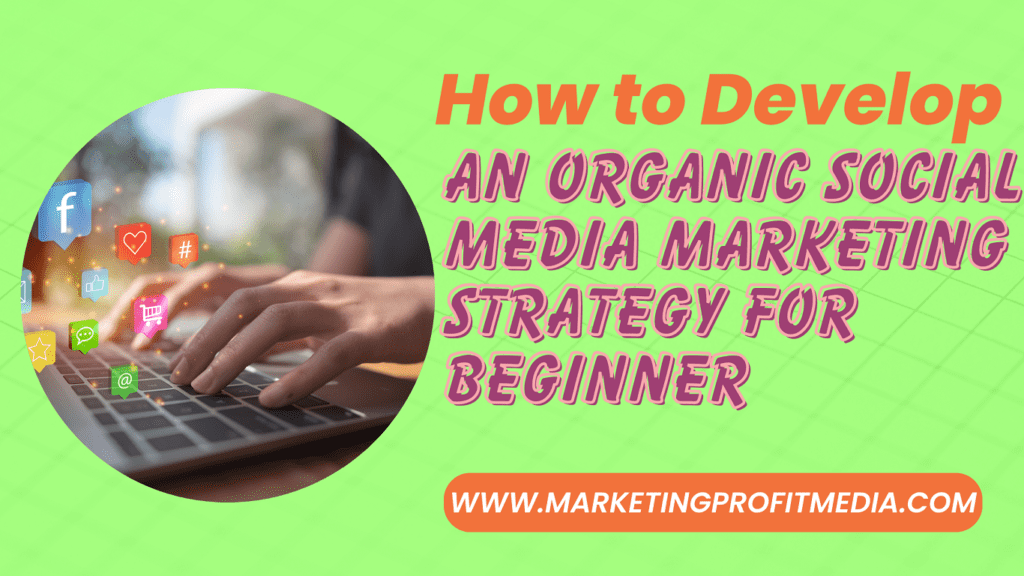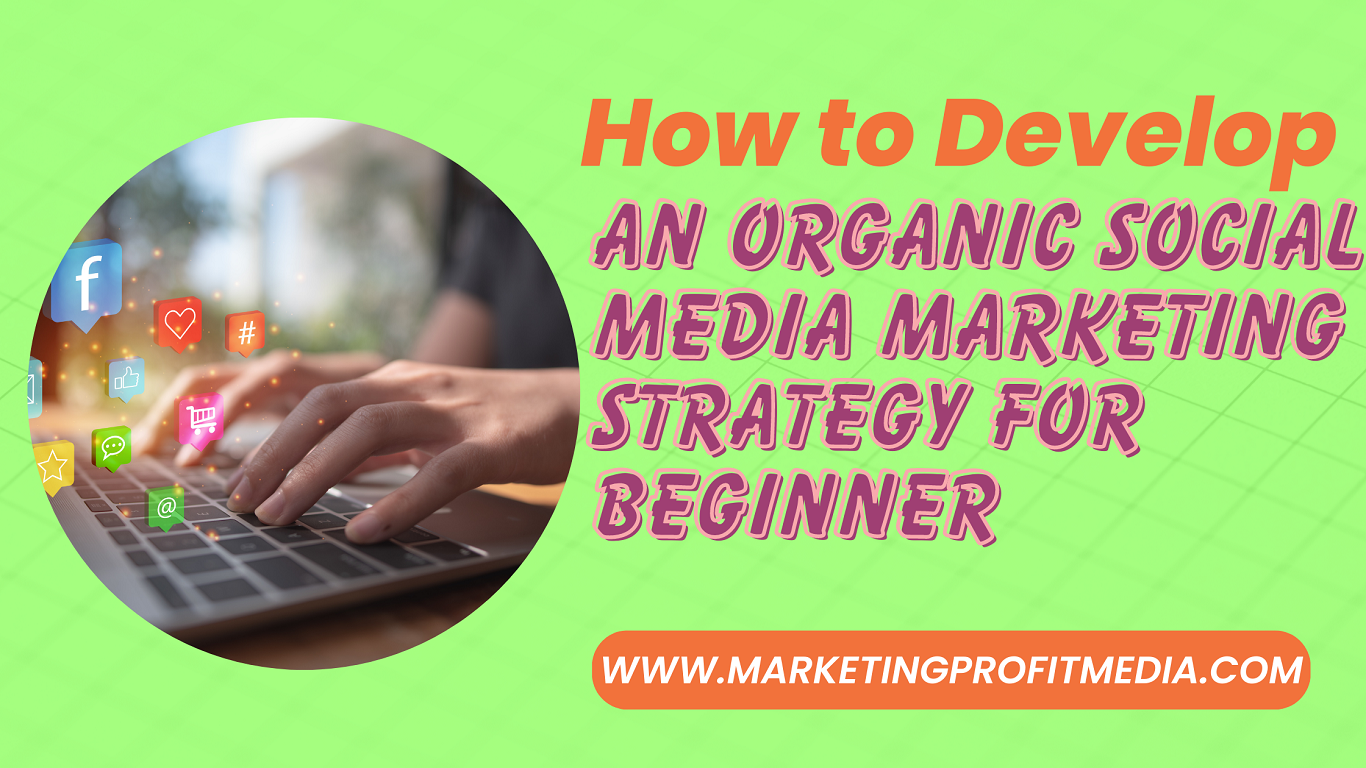How to Develop an Organic Social Media Marketing Strategy for Beginner
Social media has become an indispensable tool for businesses to connect with their audience and promote their products and services. Developing a well-thought-out organic social media marketing strategy is crucial for beginners to establish a strong online presence.

In this article, we’ll explain everything in an easy-to-follow manner. When you’re done with this course, you’ll know how to launch an organic social media marketing approach that will help you build real relationships and generate substantial participation. Let’s get started!
My Best Recommended & Proven Way to Make $100 Daily – Watch THIS FREE Training to START >>
01. Understanding Your Target Audience
Before diving into the world of social media marketing, it’s essential to have a clear understanding of your target audience. Identify the demographics, interests, and behaviors of your potential customers. Conduct thorough market research to uncover insights into their preferences and pain points. This information will be the foundation of your strategy.
02. Choosing the Right Social Media Platforms
Not all social media platforms are created equal, and not all platforms will suit your business. Different platforms cater to different audiences. Consider your target audience’s preferred platforms and focus your efforts there. For instance, if you’re targeting a younger demographic, platforms like Instagram and TikTok might be more suitable, while LinkedIn might be better for B2B audiences.
03. Setting Clear Goals and Objectives
Setting clear goals and objectives is the driving force behind a successful social media strategy. Define what you want to achieve, whether it’s increasing brand awareness, driving website traffic, or generating leads. Make sure your goals are specific, measurable, achievable, relevant, and time-bound (SMART).
04. Content Creation and Curation
The heart of your social media strategy lies in the content you create and share. Develop a mix of promotional content showcasing your products/services and informative content that provides value to your audience. Ensure that your content is visually appealing, well-written, and aligned with your brand’s voice and tone.
05. Creating a Content Calendar
Consistency is key in social media marketing. Develop a content calendar that outlines what and when you’ll post. This helps you maintain a regular posting schedule and ensures a variety of content types. Plan ahead for holidays, special promotions, and relevant industry events.
06. Engagement and Community Building
Social media is a two-way street. Engage with your audience by responding to comments, messages, and mentions promptly. Initiate conversations, ask questions, and encourage users to share their experiences. Building a sense of community around your brand fosters loyalty and trust.
07. Utilizing Hashtags and Keywords
Hashtags and keywords enhance the discoverability of your content. Research relevant hashtags and keywords in your industry and incorporate them into your posts. This increases the chances of your content reaching a wider audience and appearing in relevant searches.
08. Monitoring and Analytics
Keep a close eye on your social media analytics. Use tools provided by platforms or third-party analytics tools to track metrics such as engagement, reach, clicks, and conversions. Analyzing these metrics helps you understand what’s working and what needs adjustment.
09. Building Partnerships and Collaborations
Collaborating with influencers or other businesses can expand your reach and credibility. Partner with individuals or brands that align with your values and target audience. Influencer marketing can introduce your brand to a new audience and create authentic connections.
10. Adapting and Evolving the Strategy
The social media landscape is constantly evolving. Stay updated with platform algorithm changes and emerging trends. Be willing to adapt your strategy to accommodate these changes. Flexibility is key to staying relevant and effective.
11. Measuring and Evaluating Success
Regularly evaluate the success of your strategy against the goals you’ve set. Are you achieving the desired engagement? Are you driving the expected website traffic? Use the data you’ve gathered to make informed decisions about adjustments and improvements.
My Best Recommended & Proven Way to Make $100 Daily – Watch THIS FREE Training to START >>
Understanding Your Target Audience
Crafting a compelling organic social media strategy begins with a deep understanding of your target audience. This crucial step allows you to create content that speaks directly to their needs and aspirations. Here are few expert tips to guide you:
- Demographics Exploration: Dive into demographics like age, gender, location, and income to paint a vivid picture of your audience.
- Psychographic Insights: Explore their interests, values, behaviors, and lifestyle choices to refine your messaging.
- Problem Identification: Pinpoint the challenges your audience faces and position your brand as a solution.
- Competitor Analysis: Study your competitors’ followers to uncover potential shared interests or gaps you can fill.
- Social Media Habits: Know which platforms they frequent and when they’re most active to optimize your posting schedule.
- Language and Tone: Adapt your content’s language and tone to resonate authentically with your audience.
- Feedback Integration: Leverage feedback and comments to learn more about your audience’s preferences and concerns.
- Evolutionary Approach: Continuously refine your understanding as trends change and your audience evolves.
By delving into these insights, you’ll lay the foundation for a tailored and impactful social media strategy that genuinely connects with your target audience.
Choosing the Right Social Media Platforms
Navigating the vast landscape of social media platforms can be overwhelming, especially for beginners. However, selecting the right platforms is pivotal to the success of your organic social media strategy. Here are some insightful tips to guide you through this decision-making process:
- Audience Alignment: Identify platforms where your target audience is most active and engaged.
- Platform Demographics: Understand the demographic makeup of each platform to match it with your audience profile.
- Content Compatibility: Consider the types of content (images, videos, text) each platform favors and your ability to create them effectively.
- Business Nature: Different platforms suit different industries and business goals; choose the ones aligning with your objectives.
- Competitor Analysis: Analyze your competitors’ presence on various platforms to identify potential opportunities or gaps.
- Resource Allocation: Assess your available time and resources for maintaining multiple platforms effectively.
- Platform Trends: Stay updated on platform trends to gauge where your audience is migrating.
- Experimentation: Don’t hesitate to test platforms initially and refine your selection based on engagement metrics.
By thoughtfully considering these factors, you can confidently choose the social media platforms that resonate best with your target audience, ensuring your efforts yield maximum impact and engagement.
Setting Clear Goals and Objectives
Setting clear and attainable goals is like charting your course on a vast ocean. This navigational guide directs your efforts towards meaningful outcomes. Here are few essential tips to help you set goals and objectives that steer your organic social media strategy towards success:
- Specificity Matters: Define precise goals, whether it’s boosting brand awareness or driving website traffic.
- Measurable Metrics: Attach quantifiable metrics like engagement rate or click-through rate to your goals.
- Relevance to Business: Ensure your goals align with your overall business objectives for consistent direction.
- Realistic Ambitions: Set goals that challenge but are within reach, considering your resources and timeframe.
- Time-Bound Targets: Assign deadlines to your objectives to create a sense of urgency and accountability.
- Consistency in Messaging: Your goals should reflect your brand’s core message and values.
- Audience-Centric Goals: Tailor objectives to meet the needs and desires of your target audience.
- Periodic Evaluation: Regularly review and adjust your goals based on progress and changing circumstances.
By adhering to these goal-setting principles, you create a roadmap that keeps your organic social media strategy anchored, ensuring every effort contributes to tangible and valuable outcomes.
Content Creation and Curation
The realm of organic social media marketing, content is the currency that builds connections and fosters engagement. The art of crafting and curating content that resonates with your audience can set your strategy apart. Here are some invaluable tips to guide your content creation and curation journey:
- Know Your Audience: Tailor your content to address the needs, interests, and pain points of your target audience.
- Balance and Diversity: Mix promotional content with informative, entertaining, and educational posts.
- Storytelling Mastery: Weave compelling narratives that captivate and emotionally resonate with your audience.
- Visual Appeal: Invest in high-quality images, videos, and graphics that draw attention and enhance your message.
- Consistent Branding: Maintain a consistent brand voice, tone, and visual identity across all content.
- User-Generated Content: Encourage users to share their experiences and incorporate their content in your strategy.
- Timely Relevance: Leverage current events and trends to keep your content fresh and relatable.
- Data-Driven Insights: Analyze engagement metrics to understand which content resonates and adjust your strategy accordingly.
By adhering to these content creation and curation principles, you’ll craft a compelling narrative that speaks volumes about your brand, establishing a genuine connection with your audience and fostering engagement that stands the test of time.
Creating a Content Calendar
The bustling world of social media, consistency is the compass that guides your organic strategy. A well-crafted content calendar not only keeps your efforts organized but also ensures a steady stream of engaging content for your audience. Here are few valuable tips to help you master the art of creating a content calendar:
- Strategic Planning: Align your content with your overarching goals and themes for a cohesive strategy.
- Diverse Content Mix: Include a variety of content types, from articles and images to videos and infographics.
- Frequency and Consistency: Set a realistic posting schedule to maintain a consistent presence without overwhelming your audience.
- Evergreen and Timely: Blend evergreen content with time-sensitive posts to stay relevant and informative.
- Special Events: Incorporate holidays, industry events, and promotions to capture your audience’s attention.
- Editorial Workflow: Define roles and responsibilities within your team to ensure a smooth content creation process.
- Buffer for Flexibility: Leave room for real-time updates and spontaneous posts that align with current trends.
- Analytics Integration: Monitor engagement metrics to fine-tune your content calendar for optimal results.
With these content calendar strategies, you’ll not only streamline your efforts but also offer your audience a consistent flow of valuable content that keeps them engaged and connected.
My Best Recommended & Proven Way to Make $100 Daily – Watch THIS FREE Training to START >>
Engagement and Community Building
Engagement is the cornerstone of building this community, fostering trust, loyalty, and authentic relationships. Here are some valuable tips to guide your journey in mastering engagement and community building:
- Prompt Response: Swiftly respond to comments, messages, and mentions to show your audience their voices matter.
- Authentic Conversations: Initiate meaningful conversations and dialogues that encourage interaction and participation.
- User-Generated Content: Encourage users to share their experiences and creations, making them an integral part of your content.
- Exclusive Content: Reward your community with exclusive content, such as behind-the-scenes glimpses or sneak peeks.
- Polls and Surveys: Engage your audience by seeking their opinions through polls and surveys.
- Contests and Giveaways: Spark excitement and engagement by hosting contests and giveaways that require active participation.
- Acknowledgment: Recognize and highlight user contributions, showing your appreciation for their support.
- Consistent Interaction: Regularly interact with your audience to build a sense of familiarity and genuine connection.
By implementing these engagement and community-building strategies, you’ll foster a thriving online community that not only supports your brand but also becomes its advocate, amplifying your message and influence across the digital landscape.
Utilizing Hashtags and Keywords
Hashtags and keywords act as guiding beacons, leading your content to the eyes of your intended audience. These strategic tools enhance your content’s visibility and discoverability. Here are few essential tips to help you harness the power of hashtags and keywords effectively:
- Relevance is Key: Choose hashtags and keywords that align closely with your content’s theme and message.
- Research Trends: Stay updated on trending hashtags and keywords to ride relevant conversations.
- Niche Specificity: Opt for a mix of broad and niche hashtags to reach a wider yet targeted audience.
- Platform Compatibility: Research which hashtags perform best on each platform and tailor your choices accordingly.
- Branded Hashtags: Create a unique hashtag that represents your brand and encourages user-generated content.
- Limited but Impactful: Use a moderate number of hashtags – around 3 to 5 – for each post to avoid clutter.
- Keyword Integration: Incorporate relevant keywords organically in your captions and content.
- Constant Refinement: Regularly analyze hashtag and keyword performance and adjust your strategy accordingly.
By adopting these hashtag and keyword strategies, you’ll amplify your content’s reach and ensure it reaches the right audience, fostering engagement and conversations that resonate with your brand’s message.
Monitoring and Analytics
Monitoring and analytics provide a window into your strategy’s performance, allowing you to refine your approach for optimal results. Here are some indispensable tips to help you navigate the realm of monitoring and analytics:
- Data Tracking Tools: Leverage platform-provided analytics tools or third-party software to gather comprehensive data.
- Metric Selection: Focus on metrics aligned with your goals, whether it’s engagement, reach, or conversion rates.
- Regular Check-ins: Schedule routine check-ins to track your progress and identify trends over time.
- Audience Insights: Uncover demographics, peak activity times, and content preferences of your audience.
- Competitor Benchmarking: Analyze your competitors’ performance to gauge your strategy’s standing.
- A/B Testing: Experiment with different approaches and measure their impact on engagement and conversion.
- Adaptation and Optimization: Use data insights to make informed adjustments to your strategy for better outcomes.
- Report Visualization: Create visual reports to effectively communicate your strategy’s success to stakeholders.
By embracing these monitoring and analytics strategies, you’ll transform raw data into actionable insights, enabling you to optimize your organic social media strategy and ensure its continual growth and success.
Building Partnerships and Collaborations
Building Partnerships and Collaborations can be the catalysts that propel your organic strategy to new heights. Joining forces with like-minded individuals or brands expands your reach and credibility. Here are some invaluable tips to help you navigate the landscape of building partnerships and collaborations:
- Strategic Alignment: Seek partners whose values and objectives resonate with your brand’s mission.
- Audience Synergy: Choose collaborators with a similar target audience for maximum impact.
- Mutual Benefit: Ensure collaborations offer value to both parties, fostering a win-win scenario.
- Content Fusion: Blend each partner’s strengths to create content that’s greater than the sum of its parts.
- Clear Communication: Define roles, expectations, and timelines upfront to prevent misunderstandings.
- Authenticity Matters: Keep collaborations genuine and transparent to maintain your audience’s trust.
- Influencer Outreach: Approach influencers or thought leaders who align with your niche for powerful endorsements.
- Long-Term Relationships: Nurture partnerships beyond a single campaign for sustained growth.
By following these partnership and collaboration strategies, you’ll not only broaden your reach but also establish meaningful connections that amplify your organic social media strategy’s impact, fostering a network of loyal supporters and advocates.
Adapting and Evolving the Strategy
Adapting and evolving your organic strategy is a necessity to stay relevant and effective. Flexibility and staying ahead of trends are key to enduringgrowth. Here are some insightful tips to help you master the art of adapting and evolving your strategy:
- Trend Vigilance: Stay attuned to emerging trends and changes in social media algorithms.
- Competitor Insights: Analyze your competitors’ strategies for inspiration and identifying gaps.
- Feedback Incorporation: Integrate user feedback to refine your approach and meet their evolving needs.
- Testing Ground: Experiment with new content formats and strategies to discover what resonates.
- Data-Driven Iteration: Regularly review analytics to identify areas for improvement and optimize accordingly.
- Audience Preferences: Adapt your strategy to align with changing audience behaviors and preferences.
- Platform Dynamics: Understand how platform features evolve and leverage them to your advantage.
- Consistency Amid Change: While evolving, maintain consistent elements to retain your brand’s identity.
By embracing these adaptation strategies, you’ll ensure that your organic social media strategy remains a dynamic force that not only survives but thrives in the face of change, continuously delivering meaningful value to your audience.
Measuring and Evaluating Success
Measuring and evaluating your strategy’s performance is the compass that guides your continuous improvement journey. Here are few invaluable tips to help you navigate the realm of measuring and evaluating success:
- Goal-Alignment Metrics: Measure metrics directly tied to your set goals and objectives.
- Conversion Tracking: Analyze how your social media efforts drive website visits, sign-ups, or purchases.
- Engagement Depth: Look beyond likes and shares to delve into comments, click-through rates, and time spent on content.
- Audience Growth: Track how your strategy impacts your follower count and the quality of your audience.
- Click-Path Analysis: Understand the journey users take from social media to your website.
- Content Performance: Identify which types of content generate the most engagement and adjust accordingly.
- Platform Comparison: Evaluate the performance of different platforms to allocate resources wisely.
- Periodic Review: Regularly assess your strategy’s impact and adjust goals and tactics based on data.
By incorporating these measurement strategies, you’ll gain insights that illuminate the path to success, allowing you to fine-tune your approach, optimize your efforts, and ensure your organic social media strategy continues to thrive and evolve.
Conclusion
Crafting an effective organic social media marketing strategy requires careful planning, consistent effort, and the ability to adapt. By understanding your audience, strategically choosing platforms, setting clear objectives, creating captivating content, nurturing engagement, and embracing adaptability, you’ve built a robust framework. As you meticulously measure progress and refine your approach, remember that success in the realm of social media is a continuous evolution. Through data-driven insights and the power of genuine engagement, your strategy will not only thrive but also become a conduit for fostering lasting relationships and realizing your business goals. Keep navigating, keep evolving, and keep connecting. Your social media story has only just begun.
My Best Recommended & Proven Way to Make $100 Daily – Watch THIS FREE Training to START >>
Thanks for reading my article on “How to Develop an Organic Social Media Marketing Strategy for Beginner“, hope it will help!














